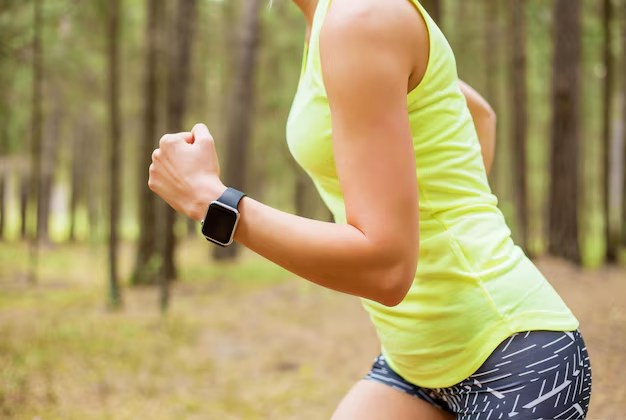In today’s fast world, staying fit and healthy has become more critical than ever. However, the world is progressing day by day. Earlier, we used a Mechanical Pedometer that operated on a pendulum, which was uncomfortable to use. Then, after some time, we started using an Electronic Pedometer that needed to be held in your hand while running. You are going to learn all about the Pedometer and how to use a pedometer in the smartwatch.
Now, the world’s progressing change has provided us with a smartwatch that not only tells the time but can also monitor our health and has dozens of features in a very compact device placed on your wrist. A smartwatch with a pedometer is a great combination. In this guide, I will address all the aspects and questions you have, as well as those you don’t have.
What Is A Pedometer?
what is a pedometer in a smartwatch? A pedometer is a device used to detect the steps a person takes and counts them by detecting the motion of the hips and hands. This device can be standalone or integrated into wearables, fitness trackers, smartwatches, and smartphones. It can even detect whether you are running or walking. Typically, it is used to monitor daily life activity and set fitness goals. Most people don’t use it as a standalone device; it works well with smartwatches or wearables.
How Does A Pedometer Work In A Smartwatch?
The process of how a pedometer works in a smartwatch is quite similar to an electronic pedometer.
1. Sensors
The smartwatch has built-in sensors, including an accelerometer and a gyroscope, and some smartwatches come with both sensors. The accelerometer continuously detects the user’s wrist movement, orientation, and body movement on a three-axis accelerometer when you move your arms while running or walking. It is essential for counting steps. The gyroscope is sometimes included in the smartwatch. It detects the velocity and rotation of your smartwatch when you run or walk. It can detect more complex wrist movements, such as when you twist your wrist to check the time or when you flip your wrist to silence a call.
2. Data Collection
The pedometer collects data on how many steps you took, the speed of each step, and data on the direction and intensity of your wrist movement, such as when you are running or walking. Sensors can determine the duration of your wrist movement, including when it started and when it ended, as well as monitor the pattern of your sleep.
3. Data Processing
After data collection, the device processes the data intelligently to distinguish between walking, running, or sleeping.
4. Display
The data is displayed on your smartwatch screen and categorized by headings to make it easy to read.
5. Syncing And Storage
The results you get on your smartwatch are temporarily stored in your smartwatch. The main reason is to provide you with real-time information. To maintain long-term results for your health and fitness, you need to sync your data with the companion app on your smartphone using the companion app because smartwatch storage capacity is limited. But if it has more storage, then tracking your old activity is a little bit uncomfortable because of its small screen size.
How To Check If My Smartwatch Supports Pedometer Functionality
Many people start investing their energy in using a pedometer and exploring new features on their smartwatches to enable the pedometer function. They just want to know “How to use a pedometer in a smartwatch”. However, what they really need to understand is the smartwatch’s compatibility with a pedometer. Here are the following steps to determine compatibility
- First, you need to check the manual guide and look for the fitness tracking feature because some smartwatches have fitness tracking apps.
- Go to your settings, swipe down, and look for fitness tracking or the health section.
- Many smartwatches have pre-installed fitness-tracking apps. Go to your app drawer and look for health and fitness-related apps.
- Some smartwatches require you to install a companion app on your phone to access the advanced features of the app.
- If there is no pre-installed app on your smartwatch, you just need to install it from the Google Play Store.
How to Use a Pedometer in the Smartwatch
- Wear a smartwatch: you can’t get accurate results by grabbing a smartwatch only, you need to wear it accurately.
- Locate the App: The majority of smartwatches come with an internal health or fitness application. Refer to symbols or titles like “Steps,” “Fitness,” or “Activity”.
- Accessing the App: This will display your current step count with distance and calories burned.
- Setting Goals: You can set your daily step goals. By doing this, you will stay motivated.
- Start Walking:
6 Tips To Get Accurate Pedometer Readings in a Smartwatch
1. Wear Your Smartwatch Correctly
- Wear your smartwatch accurately, and place it on the top of your wrist to help the smartwatch collect accurate data. It should not be too tight and make you feel uncomfortable. The position should not change while running or during activities because it will affect recording accurate readings. Make sure that the position remains the same as the position you set while wearing it.
- Make sure that your smartwatch is in contact with your skin because the sensor needs to be in close contact with your skin to measure readings accurately.
2. Get Personalized Results
Some smartwatches allow you to provide input before using the pedometer, such as your age, gender, weight, and height, to provide you with more personalized results and accuracy.
3. Keep The Pedometer App Updated
You have to keep your pedometer app updated. It enhances performance and can prevent you from collecting incorrect information about your fitness.
4. Activate GPS if Available
Enabling GPS can provide you with the best and extremely accurate results during outdoor activities and running compared to using sensors alone.
5. Understand Its Limitations
Keep in mind that a pedometer may have some limitations. It might not provide you with accurate results when you are running slowly or cycling, and a smartwatch counting steps while driving gives you inaccurate results.
6. Maintain Your Device
As you know, every device needs maintenance. You have to keep it clean; otherwise, the sensors may become blocked. Charge it at least twice a day, and try to keep it on your smartwatch rather than letting it run out of battery.
Benefits Of Using A Pedometer In A Smartwatch

As I briefly informed you about what you can achieve using a pedometer and how it can impact your daily life, here is a list of benefits to help you better track and manage your health.
1. Step Tracking
The pedometer in your smartwatch can count the steps you took and how long you walked throughout the day, providing you with daily results.
2. Motivation
When you continuously monitor your activity, some smartwatches allow you to set fitness goals. For example, you can aim to walk 1000 steps a day, and your smartwatch helps you achieve the goal. You can track your trend to see which days you walked more and which days you were less active.
3. Calorie Burn Estimate:
In some smartwatches, a pedometer can also estimate the number of calories you have burned based on your activity, which is a useful feature.
4. Health Monitoring:
Based on your step counts, the pedometer can suggest other health factors like heart rate, stress levels, and sleep patterns. how does a smartwatch measure sleep? It depends on several factors like the Duration of your sleep, quality of your sleep, and many more.
5. Competition And Social Interactions:
One of the best features of the pedometer is that you can share your performance record with your friends through social media platforms and compete with them, which makes you more
focused on your fitness goals.
6. Scientific Research:
Pedometers play a significant role in scientific research when scientists want to study how physical activity affects people’s health and fitness. They can gather accurate information quickly, which is faster than manual data collection. However, these trackers should be tested before conducting a survey.
How to Sync Pedometer Readings from Smartwatch to Phone
Compatibility
First, check if your smartphone is compatible with your smartwatch. If your watch is Android-based, your phone should also be Android-based, and if your phone is an iPhone, your smartwatch should also be an Apple Watch.
Connect Via Bluetooth
Connect your watch to your phone using Bluetooth.
Install The Companion App
Many smartwatches have companion apps, & you need to download and install a companion app on your phone to manage your watch and sync data.
Sync Data
Once your phone is paired with your smartwatch, you can simply open the app on your phone and sync data from your smartwatch to your phone. The steps may vary depending on different smartwatch models.
How To Troubleshoot Common Issues While Using The Pedometer
In some cases, you might face these kinds of issues, Why is my smartwatch not counting my steps? And why sensors are not working? And many more, but by the following steps, you can easily troubleshoot the issues.
Calibrate Your Smartwatch Pedometer
You can calibrate your smartwatch if you face step-counting issues. If you encounter this issue, you will need to set your stride length. To do this, first, measure the length of your steps. Walk 50 meters and count the number of steps you take. Then, divide the distance you have covered by the number of steps you took. For example, if you took 70 steps while walking 50 meters, the calculation would be 50 meters (distance) / 70 steps = 0.71 meters (covered per step) or 71 centimeters (covered per step). Go to your pedometer settings in your smartwatch and set your stride length. This tells the smartwatch how much distance is covered when you take one step.
Check Motion Sensors
As mentioned above, dirt and dust can affect your smartwatch sensors and, ultimately, your results.
Check Sensor Permissions
Sometimes, sensors do not work until permission is granted. You need to check the sensor permissions and turn them on.
Battery Level
Yes, the battery level affects the performance of the pedometer. Make sure the battery is fully charged before using the pedometer.
Restart Your Smartwatch
When your problem is still not resolved, try restarting your smartwatch. Sometimes, it can solve minor problems in the pedometer’s software.
Factory Data Reset
If your issue is still not resolved, consider a factory reset on your smartwatch. Keep in mind that it will erase all the data on your smartwatch.
Conclusion
Using a pedometer in your smartwatch is an excellent way to enhance your fitness journey and monitor your health effortlessly. The evolution from mechanical to electronic pedometers has now culminated in the integration of this valuable tool into smartwatches. With sensors like accelerometers and gyroscopes, your smartwatch can accurately track your steps, detect various activities, and even provide personalized health insights. It’s a versatile companion that motivates you to stay active, set goals, and compete with friends. The future of pedometers in smartwatches is promising. As technology continues to advance, we can expect even more precise data, enhanced health monitoring features, and seamless integration with smartphones and other devices. Hope now you understand how to use a pedometer in the smartwatch. So, embrace this valuable tool on your wrist and let it guide you toward a healthier and more active lifestyle.

